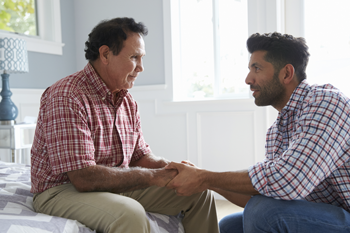Elder abuse is an intentional act or failure to act that causes or creates a risk of harm to an older adult. An older adult is someone age 60 or older. The abuse occurs at the hands of a caregiver or a person the elder trusts. Common types of elder abuse include:
- Physical abuse is when an elder experiences illness, pain, injury, functional impairment, distress, or death as a result of the intentional use of physical force and includes acts such as hitting, kicking, pushing, slapping, and burning.
- Sexual abuse involves forced or unwanted sexual interaction of any kind with an older adult. This may include unwanted sexual contact or penetration or non-contact acts such as sexual harassment.
- Emotional or Psychological Abuse refers to verbal or nonverbal behaviors that inflict anguish, mental pain, fear, or distress on an older adult. Examples include humiliation or disrespect, verbal and non-verbal threats, harassment, and geographic or interpersonal isolation.
- Neglect is the failure to meet an older adult’s basic needs. These needs include food, water, shelter, clothing, hygiene, and essential medical care.
- Financial Abuse is the illegal, unauthorized, or improper use of an elder’s money, benefits, belongings, property, or assets for the benefit of someone other than the older adult.
For more information about elder abuse definitions please see Elder Abuse Surveillance: Uniform Definitions and Recommended Core Data Elements pdf icon[3.8 MB, 124 Pages, 508]. In the following section, physical forms of elder abuse will be examined in more detail.
Elder abuse is a serious problem in the United States. The available information is an underestimate of the problem because the number of nonfatal injuries is limited to older adults who are treated in emergency departments. The information doesn’t include those treated by other providers or those that do not need or do not seek treatment. Additionally, many cases are not reported because elders are afraid or unable to tell police, friends, or family about the violence. Victims have to decide whether to tell someone they are being hurt or continue being abused by someone they depend upon or care for deeply.
Elder abuse is common. Abuse, including neglect and exploitation, is experienced by about 1 in 10 people aged 60 and older who live at home. From 2002 to 2016, more than 643,000 older adults were treated in the emergency department for nonfatal assaults and over 19,000 homicides occurred.
Some groups have higher rates of abuse than others. Compared with women, men had higher rates of both nonfatal assaults and homicides. The rate for nonfatal assaults increased more than 75% among men (2002–2016) and more than 35% among women (2007–2016). The estimated homicide rate for men increased 7% from 2010 to 2016. Compared to non-Hispanic Whites, non-Hispanic Black or African American persons, non-Hispanic American Indian/Alaskan Natives, and Hispanic or Latino persons have higher homicide rates (2002–2016).
Overall and firearm-specific older adult homicide rates increased between 2014 and 2017. Of the 6188 victims, 62% were male. The perpetrator was an intimate partner in 39% of firearm homicides and 12% of non-firearm homicides. Common contexts of firearm homicides were familial/intimate partner problems, robbery/burglary, argument, and illness-related (e.g. the homicide was perpetrated to end the suffering of an ill victim, both victim and perpetrator had an illness, or the perpetrator had a mental illness).
Elder abuse can have several physical and emotional effects on an older adult. Victims are fearful and anxious. They may have problems with trust and be wary of others. Many victims suffer physical injuries. Some are minor, like cuts, scratches, bruises, and welts. Others are more serious and can cause lasting disabilities. These include head injuries, broken bones, constant physical pain, and soreness. Physical injuries can also lead to premature death and make existing health problems worse.
There are a number of factors that may increase or decrease the risk of perpetrating and/or experiencing elder abuse. To prevent elder abuse, we must understand and address the factors that put people at risk for or protect them from violence.
- Listen to older adults and their caregivers to understand their challenges and provide support.
- Report abuse or suspected abuse to local adult protective services, long-term care ombudsman, or the police. Use the National Center on Elder Abuse Listing of State Elder Abuse Hotlinesexternal icon to find your state’s reporting numbers, government agencies, state laws, and other resources.
- Educate oneself and others about how to recognize and report elder abuse.
- Learn how the signs of elder abuse differ from the normal aging process.
- Check-in on older adults who may have few friends and family members.
- Provide over-burdened caregivers with support such as help from friends, family, or local relief care groups; adult day care programs; counseling; outlets intended to promote emotional well-being.
- Encourage and assist persons (either caregivers or older adults) having problems with drug or alcohol abuse in getting help.
The older adult population is growing faster in the U.S. than are younger populations. Many older adults require care and are vulnerable to violence perpetrated by a caregiver or someone they trust. More research is needed to uncover the causes for, and solutions to, violence against older adults.
Content retrieved from: https://www.cdc.gov/violenceprevention/elderabuse/fastfact.html.

